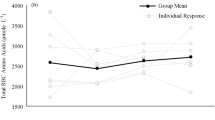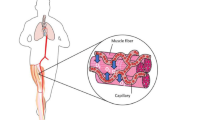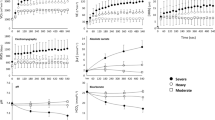Abstract
The pioneering development of the knee-extensor exercise model opened a new dimension in the study of human muscle physiology allowing the measurement of blood flow (Q), oxygen uptake (VO2), and work rate in an isolated muscle (Andersen et al., 1985). Original studies using this exercise paradigm reported reduced O2 extractions presumably as a consequence of the greater maximal muscle Q (Andersen & Saltin, 1985). Although this human in situ model has elevated the maximum recorded muscle Q in man from the previously recorded values of 60-100 ml• 100g • min-1 (Mellander, 1981) to values of 250-300 m1-100g • min-1, it was still not apparent that this was maximal human muscle Q (Rowell, 1988). A recent experiment was performed to determine if human muscle Q could be elevated above these previously reported values during knee-extensor exercise by recruiting athletic subjects and utilizing a rapidly incremented protocol (Richardson et al., 1993). In this study quadriceps muscle Q(x ± SE, 385 ± 26 ml • min-1100g), VO2max (60.2 ± 5.8 ml • min-l• 100g-1), and work rate (4.3 ± 0.3 W • 100g-1) were by far the highest yet recorded. Despite these being the highest recorded muscle blood flows in man, O2 extraction at Vo2max did not appear to be compromised to any greater extent than in conventional cycle exercise (Richardson et al., 1993). Extraction at any given Vo2 is determined largely by convective O2delivery, capillary surface area available for O2 uptake, and the resultant time available for O2 release (Honig et al., 1991). It is the objective of this paper to focus on the third of these factors which. equates to red blood cell (RBC) transit time during these high human muscle Q (Richardson et al., 1993). Previously, it has been demonstrated theoretically that transit time and its variability are major determinants of O2 extraction from red cells at exercise (Gayeski et al., 1988).
Access this chapter
Tax calculation will be finalised at checkout
Purchases are for personal use only
Preview
Unable to display preview. Download preview PDF.
Similar content being viewed by others
References
Andersen, P. Capillary density in skeletal muscle in man. Acta Phvsio. Scand. 95: 203–205,1975.
Andersen, P., and J. Henricksson. Capillary supply of the quadriceps femoris muscle in man: Adaptive response to exercise. J. Phvsiol. 270: 677–690,1977.
Andersen, P., and B. Saltin. Maximal perfusion of skeletal muscle in man. J. Phvsiol. 366: 233–249,1985.
Andersen, P., R. P. Adams, G. Sjogaard, A. Thorbe, and B. Saltin. Dynamic knee extension as a model for study of isolated exercising muscle in humans. J. Appl. Phvsiol. 59: 1647–1653,1985.
Bangsbo, J., P. D. Gollnick, T. E. Graham, C. Juel, B. Kiens, M. Mizuno, and B. Saltin. Anaerobic energy-production and 02 deficit-debt relationship during exhaustive exercise in humans. J. Physiol. 422: 539–559,1990.
Brodal, P., F. Ingjer, and L. Hermansen. Capillary supply of skeletal muscle fibers in untrained and endurance-trained men. Am. J. Physiol. 232: H705–H712,1977.
Coyle, E. F., A. R. Coggan, M. K. Hopper, and T. J. Walter. Determinants of endurance in well-trained cyclists. J. Appl. Phvsiol. 64: 2622–2630,1988.
Cutts, A. The range of lengths in the muscles of the human lower limb. J. Anat. 160: 79–88,1988.
Gayeski, T. E. J., W. J. Federspiel, and C. R. Homg. A graphical analysis of the influence of red cell transit time, carrier free layer thickness, and intracellular P02 on blood tissue O2 transport. Adv. Exp. Med. Biol. 222: 25–35,1988.
Hermansen, L., and M. Watchtlova. Capillary density of skeletal muscle in well-trained and untrained men. J. Appl. Physiol. 30: 860–863,1971.
Honig, C. R., C. L. Ordoroff, and J. L. Frierson. Active and passive capillary, control in red muscle at rest and in exercise. Am. J. Physiol. 243: H196–H206,1982.
Honig, C. R., T. E. J. Gayeski, and K. Groebe. Myoglobin and Oxygen Gradients. In: The Lung: Scientific Founditions, 1st ed., edited by R. G. Crystal, and West, J. B. New York: Raven Press, Vol. 2, 1991, p. 1489–1496.
Ivy, J. L., R. T. Withers, P. J. Van Handel, D. H. Elger, and D. L. Costill. Muscle respiratory capacity and fiber type as determinants of lactate threshold. J. Appl. Physiol. 48: 523–527,1980.
Jones, P. R. M., and J. Pearson. Anthropometric determination of leg fat and muscle plus bone volumes in young male and female adults. J. Physiol. 294: 63P,1969.
Klitzman, B., and B. R. Duling. Microvascular hematocrit and red cell flow in resting and conrtacting striated muscle. Am. J. Physiol. 237: H481–H490,1979.
Knight, D. R., D. C. Poole, W. Schaffartzik, H. J. Guy, R. Prediletto, M. C. Hogan, and P. D. Wagner. Relationship between body and leg V02 during maximal cycle ergometry. J. Appl. Physiol. 73: 1114–1121,1992.
Knight, D. R., W. Schaffartzik, D. C. Poole, M. C. Hogan, D. E. Bebout, AND P. D. Wagner. Hyperoxia increases leg maximal oxygen uptake. J. Appl. Phvsiol. 75: 2586–2594,1993.
Mai, J. V., V. R. Edgerton, and R. J. Barnard. Capillarity of red, white and intermediate muscle fibers in trained and untrained guinea-pigs. Experientia 26: 1222–1223,1970.
Mathieu-Costello, O. Capillary tortuosity and degree of contraction or extension of skeletal muscles. Microvasc. Res. 33: 98–117,1987.
Mathieu-Costello, O., C. G. Ellis, R. F. Potter, I. C. Macdonald, and A. C. Groom. Muscle capillary-to-fiber ratio: morphometry. Am. J. Phvsiol. 261: H1617–H1625,1991.
Mellander, S. Differentiation of fiber composition, circulation, and metabolism in limb muscles of dog, cat, and man. In: Mechanisms of vasodilation, 1st ed., edited by P. M. Vanhoutte, and Leusen, I. New York: Raven, 1981, p. 243–254.
Poole, D. C., G. A. Gaesser, M. C. Hogan, D. R. Knight, AND P. D. Wagner. Pulmonary and leg V02 during submaximal exercise: implications for muscular efficiency. J. Appl. Phvsiol. 72: 805–810,1992.
Richardson, R. S., S. C. Johnson, and M. S. Walker. Heart rate V02 relationship changes following intense training. Sports Med., Training, and Rehab. 3: 105–111,1992.
Richardson, R. S., D. C. Poole, D. R. Knight, S. S. Kurdak, M. C. Hogan, B. Grassi, E. C. Johnson, K. Kendrick, B. K. Erickson, and P. D. Wagner. High muscle blood flow in man: Is maximal 02 extraction compromised? J. Appl. Phvsiol. 75: 1911–1916,1993.
Rowell, L. B. Muscle blood flow how high can it go? Med. Sci. Sports. Exerc. 20: S97- S103,1988.
Rowell, L. B., B. Saltin, B. Kiens, and N. J. Christensen. Is peak quadriceps blood flow in humans even higher during exercise with hypoxemia? Am. J. Phvsiol. 251: H1038- H1044,1986.
Saltin, B., C. G. Blomqvist, J. H. Mitchell, R. C. Jr. Johnson, K. Wildenthal, and C. B. Chapman. Responses to exercise after bed rest and training. Circulation 38: 1–78,1968.
Saltin, B., B. Kiens, G. Savard, and P. K. Pedersen. Role of hemoglobin and capillarization for oxygen delivery and extraction in muscular exercise. Acta Phvsio. Scand. 128(Suppl. 556): 21–32,1986.
Whipp, B. J., AND K. Wasserman. Oxygen uptake kinetics for various intensities of constant-load work. J. Appl. Phvsiol. 33: 351–356,1972.
Author information
Authors and Affiliations
Editor information
Editors and Affiliations
Rights and permissions
Copyright information
© 1994 Springer Science+Business Media New York
About this chapter
Cite this chapter
Richardson, R.S., Poole, D.C., Knight, D.R., Wagner, P.D. (1994). Red Blood Cell Transit Time in Man: Theoretical Effects of Capillary Density. In: Hogan, M.C., Mathieu-Costello, O., Poole, D.C., Wagner, P.D. (eds) Oxygen Transport to Tissue XVI. Advances in Experimental Medicine and Biology, vol 361. Springer, Boston, MA. https://doi.org/10.1007/978-1-4615-1875-4_91
Download citation
DOI: https://doi.org/10.1007/978-1-4615-1875-4_91
Publisher Name: Springer, Boston, MA
Print ISBN: 978-1-4613-5763-6
Online ISBN: 978-1-4615-1875-4
eBook Packages: Springer Book Archive




